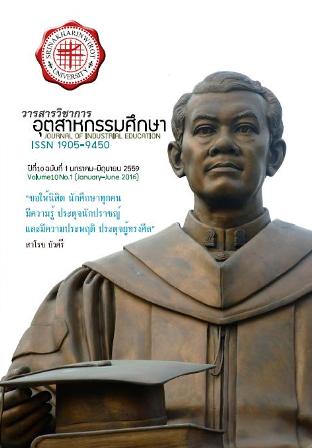การพัฒนาคู่มือการเทียบโอนความรู้และประสบการณ์ของการอาชีวศึกษา
Abstract
บทคัดย่อ การวิจัย เรื่อง การพัฒนาคู่มือการเทียบโอนความรู้และประสบการณ์ของการอาชีวศึกษา มีความมุ่งหมายเพื่อพัฒนาคู่มือฯ และประเมินประสิทธิภาพของคู่มือฯ ดังกล่าว วิธีดําเนินการวิจัยออกเปน 2 ขั้นตอน ได้แก่ ขั้นตอนที่ 1 การพัฒนาคู่มือฯ โดยใช้ข้อมูลจากแบบสอบถามการดำเนินงานการเทียบโอนฯของสถานศึกษาสังกัดสำนักงาน สอศ.ทั่วประเทศ จำนวน 202 แห่งและการสัมภาษณ์แบบเจาะลึกผู้ที่มีส่วนเกี่ยวข้องของสถานศึกษาที่เป็นกรณีศึกษาจำนวน 6 แห่ง โดยศึกษาปัจจัยที่ส่งผลต่อการดำเนินงานฯ ได้แก่ สมรรถนะของสถานศึกษา (Capacity) สิ่งจูงใจ (Incentives) และข้อมูลข่าวสาร (Information) ในขั้นตอนที่ 2 การประเมินประสิทธิภาพของคู่มือฯ โดยการประชุมสนทนากลุ่มผู้แทนสถานศึกษาและแบบประเมินคู่มือฯ โดยใช้เกณฑ์การประเมิน คือ ความเหมาะสมและความเป็นไปได้ในการนำคู่มือฯไปใช้ ผลการวิจัย พบว่า ความคิดเห็นที่มีต่อปัจจัยในการดำเนินงานเทียบโอนฯ อยู่ในระดับ "มาก" ทั้ง 3 ปัจจัย คือ สมรรถนะฯ ( = 4.22, S.D. = .501) สิ่งจูงใจ ( = 4.25, S.D. = .568) และข้อมูลข่าวสาร ( = 4.24, S.D. = .533) ในขณะเดียวกัน ระดับความสำคัญของปัจจัย พบว่า อยู่ในระดับ "มาก" ทั้งหมดเช่นเดียวกัน คือ สมรรถนะฯ ( = 2.65, S.D. = .383) สิ่งจูงใจ ( = 2.64, S.D. = .473) และด้านข้อมูลข่าวสาร ( = 2.65, S.D. = .404) ทั้งนี้ ผลการประเมินประสิทธิภาพของคู่มือฯ ที่มีองค์ประกอบจำนวน 4 บท นั้น พบว่า การประเมินในภาพรวมเนื้อหาของคู่มือฯ มีความเหมาะสมในระดับ "มากที่สุด" คิดเป็นร้อยละ 83.3 เช่นเดียวกับความเป็นไปได้ในการนำเนื้อหาของคู่มือฯไปใช้ที่อยู่ในระดับ "มากที่สุด" คิดเป็นร้อยละ 83.3 แสดงว่าคู่มือฯ มีประสิทธิภาพตามสมมติฐานที่ตั้งไว้ โดยสรุป คู่มือฯ ที่ได้พัฒนาขึ้นสามารถนำไปใช้เป็นแนวทางในการดำเนินงานการเทียบโอนฯ ทั้งในระดับสถานศึกษาและศูนย์ประเมินสมรรถนะผู้เรียนอาชีวศึกษาเพื่อให้สามารถปฏิบัติตามข้อกำหนดและมาตรฐานได้อย่างมีประสิทธิภาพ คำสำคัญ : คู่มือ, การเทียบโอนความรู้และประสบการณ์, การอาชีวศึกษา Abstracts The objectives were to develop a guideline on recognition of prior learning in vocational education and to evaluate the effectiveness of the guideline. The research is composed of two procedures. Firstly, the development of the guideline, gathering information on recognition of prior learning from 202 vocational colleges under OVEC and in-depth interviews in 6 best - practice colleges by interviewing 3 groups of stakeholders including directors, teachers and students, concentrating on 3 factors: College Capacity, Incentives and Information. Secondly, the evaluation of the effectiveness of the guideline was conducted by focus group discussions and an evaluation form which focused on 3aspects:Format, Content and Overall evaluation. It was found that the level of agreement towards the implementation of the recognition of prior learning process were at the "High" level in all factors: College Capacity ( = 4.22, S.D. = .501), Incentive ( = 4.25, S.D. = .568)and Information ( = 4.24, S.D. = .533). Also the level of importance were at the "High" level in all factors: College Capacity ( = 2.65, S.D. = .383), Incentive ( = 2.64, S.D. = .473)and Information ( = 2.65, S.D. = .404). The effectiveness of the guideline, which consists of 4 chapters gave overall evaluation of the suitability of the guideline was at the "Highest" level (83.3 percent) Likewise the overall evaluation of applicability was at the "Highest" level (83.3 percent). It emerged that the guideline can be used according to the research hypothesis. In conclusion, the study found that it is possible of the guideline can be applied by vocational colleges and provincial assessment centers in order to comply with the procedures and maintain standards effectively. Keywords: Guideline, Recognition of Prior Learning, Vocational EducationDownloads
Download data is not yet available.
Downloads
Issue
Section
บทความวิจัย







